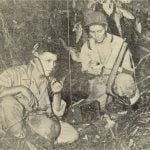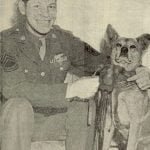
The war has ended in victory for the United Nations, and after a troubled period of readjustment and reorganization, peace will come at last. The story of the Indians’ contribution to the winning of the war has been told only in part; and new material will be coming in for many months. As one of the Sioux boys says, “As a rule nowadays the fellows don’t go in for heroics.” But already the Indian record is impressive. In the spring of 1945, there were 2 1,767 Indians in the Army, 191 in the Navy, 121 in the Coast Guard, and 723 in the Marines. These figures do not include officers, for whom no statistics are avoidable. Several hundred Indian women are in the various branches of the services. The Standing Rock Agency, North Dakota, estimates that at least fifty girls from that jurisdiction are in uniform.
The Office of Indian Affairs has recorded 71 awards of the Air Medal, 51 of the Silver Star, 47 of the Bronze Star Medal, 34 of the Distinguished Flying Cross, and two of the Congressional Medal of Honor. There are undoubtedly many more which have not been reported. Many of these ribbons are decorated with oak leaf clusters awarded in lieu of additional medals. It is not unusual to see an Air Medal with nine oak leaf clusters, or twelve, or even fourteen.
The casualty lists are long. They come from theatres of war all over the world. There were many Indians in the prison comps of the Philippines after the fall of Batoan and Corrugators, and later there were many more on Iwo Jima and Okinawa. There were Indians in the 45th Division in Sicily and Italy. They were at Anzio, and they took part in the invasion on D-Day in Normandy. A Ute Indian, LeRoy Hamlin, was with a small troop, which made the first contact with the Russians across the Elbe on April 25. Another Ute, Harvey Natchees, was the first American soldier to ride into the center of
Berlin. Pfc. Ira Hayes, Pima, of the Marines, was one of the six men who raised the flag on the summit of Mt. Suribachi. Once in a while, an Indian diving into a foxhole when shells began to burst, would find himself face to face with another member of his race, and they would start talking about Indian problems as they waited for the enemy fire to cease. When there was only one Indian in an outfit, he was inevitably called Chief, which amused him and perhaps pleased him a little.
The Indian people at home hove matched the record of their fighting men. Mare than forty thousand left the reservations during each of the war years to take jobs in ordnance depots, in aircraft factories, on the railroads, and in other war industries. The older men, the women, and the children, who stayed at home, increased their production of food in spite of the lock of help. The Indians invested mare than $17,000,000 of restricted funds in war bonds, and their individual purchases probably amount to twice that sum. They subscribed liberally to the Red Cross and to the Army and Navy Relief societies. The mothers of the soldiers organized War Mothers clubs in their communities, and every soldier received letters and gifts while he was in the service. The clubs helped to entertain the boys who come home on furlough, and now that the war is over, they are making plans for war memorials in honor of the fallen.
Reflecting the heroic spirit of Indians at war in every theater of action, the list of those specially selected to receive military honors grows steadily. We shall never know of oil the courageous acts performed “with utter disregard for personal safety,” but the proved devotion of all Indian peoples on the home front and the conspicuous courage of their sons and daughters in the various services entitle them to share in common the honors stowed upon the few here noted.
Congressional Medal of Honor
The blue star-sprinkled ribbon of the highest award of all is given for “conspicuous gallon try at the risk of life above and beyond the call of duty.” Relatively few of these medals hove been given, and the nation may well be proud of the fact that two Indians thus far hove won it. The story of Lt. Ernest Childers, Creek, was told in Indians at Work for May-June 1944; that of Lt. Jock Montgomery, Cherokee, in the January-February number, 1945.
Distinguished Flying Cross
The highest aviation honor is given for heroism or extraordinary achievement while participating in aerial flight. The ribbon is blue, with a white-bordered red stripe in the center and white stripes near the ends. Thirty or mare Indians have been awarded this medal thus for, and their stories hove been told in various issues of Indians at Work.
Mention has already been made of Lt. William R. Fredenberg, Menominee, of Wisconsin, who wears this ribbon and also has the Air Medal with seven oak leaf clusters. The citation for the DFC reads as follows:
“Lieutenant Fredenberg demonstrated superior skill in the execution of a dive-bombing attack upon heavily defended marshalling yard wherein he personally destroyed three locomotives and thereafter in the face of heavy and accurate enemy fire remained in the target area strafing installations until his ammunition was exhausted. The outstanding flying ability and tactical proficiency which he exhibited on this occasion reflected the highest credit upon himself and his organization.”
Sgt. Shuman Shaw, a full-blood Pointe from California, was wounded on his third mission OS tail-gunner on a B-24 Liberator, but he stayed with his guns and shot down two of the enemy, with three mare probably destroyed. During his 22nd mission, while raiding strategic installations at Budapest, he was again seriously wounded. On both occasions he was given plasma. Sgt, Shaw has the Distinguished Flying Cross, the Air Medal with three oak leaf clusters, the Presidential Unit Citation, and the Purple Heart with oak leaf cluster.
Air Medal, Distinguished Flying Cross

Harold E. Rogers, Seneca from Miami, Oklahoma, was reported missing in action on July 3, 1944, when his plane failed to return from a mission over Budapest. Sgt. Rogers had flown 25 missions with the 8th Air Force in England, and then served as instructor in the United States for six months. He went bock into action, this time with the 1 5th Air Force, based in Italy. He wore the Air Medal with nine oak leaf clusters, and the Distinguished Flying Cross. The Purple Heart was awarded to him posthumously. His wife, a Pottawatomi from Kansas, who now lives in Hollywood, was a student at Haskell Institute with her husband, and Sgt. Rogers was studying law at the time he entered the service. He also attended Sherman Institute and Riverside Junior College.
